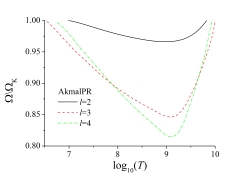Gravitational wave asteroseismology of fast rotating neutron stars with realistic equations of state
May 2013
Daniela D. Doneva, Erich Gaertig, Kostas D. Kokkotas and Christian Krüger
Fast rotating neutron stars can be destabilized by the so-called Chandrasekhar-Friedman-Schutz (CFS) instability, i.e. certain nonaxisymmetric oscillation modes can become unstable due to the emission of gravitational radiation for very high rotation rates of the star. If the requirements for this instability are met, the amplitude of the modes will grow exponentially even if they are only weakly excited which could potentially lead to detectable amount of gravitational radiation. Such high rotational rates are supposed to be observed for example in the newborn neutron stars.
One of the major challenges following the detection of gravitational waves from oscillating neutron stars is to infer its characteristic parameters like mass, radius and rotation rate via the observed data. In order to do that, we should build accurate theoretical models. That is why we study quadrupolar and higher order oscillations of fast rotating neutron stars within the Cowling approximation, where some of the modern realistic equations of state of the nuclear matter are employed. We derive improved empirical relations for gravitational wave asteroseismology with f -modes which connect the observed frequencies and damping times to the mass, radius and rotational rate of the neutron stars.
We also compute the instability window for certain models, i.e. the range of parameter where the CFS instability overcomes the dissipative effects. It turns out that the window can be larger when realistic equations of state are considered compared to the polytropic case.
Phys. Rev. D 88, 044052 (2013) arXiv:1305.7197 [astro-ph.SR]

